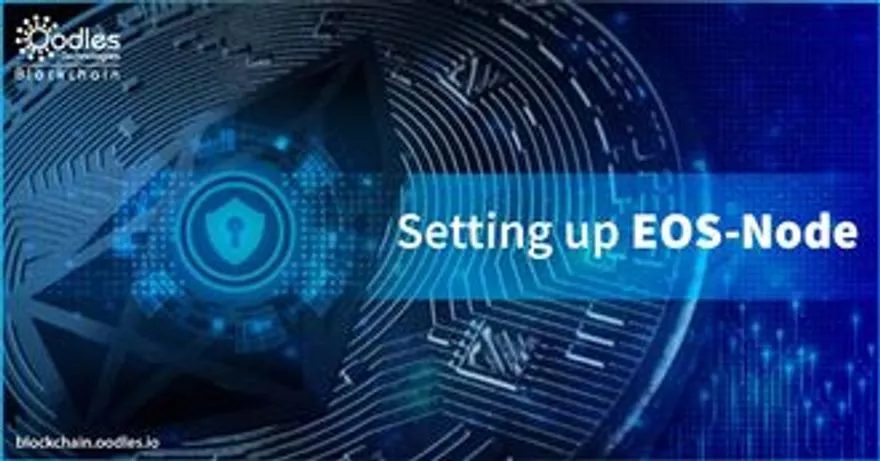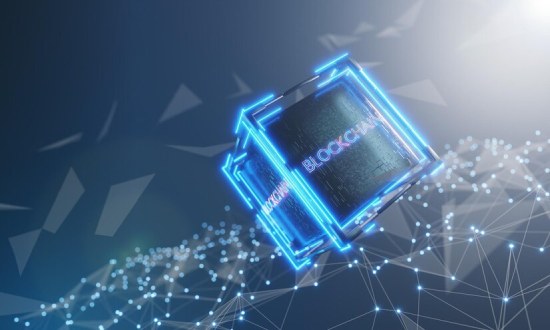-
EOS is becoming a popular platform for blockchain application development. Its high scalability enables it to process a large number of transactions quickly. Moreover, these transactions are validated by EOS nodes. These nodes produce blocks containing valid transactions. This blog is a guide to setting up EOS Node in simple steps.
EOS Blockchain
EOS is a blockchain (and a coin) used to build 'smart' smart contracts like Ethereum but it's much faster than it. Any user who wants to use the EOS platform for creating an account, transferring a token, and issuing a token must have an EOS token to successfully perform the aforementioned actions. Furthermore, every user on the EOS blockchain platform holds an amount (in EOS ) for stake network bandwidth, net usage, and RAM. So, only an existing user could create a new user as they purchase above- defined asset and gives them to new users (for independent EOS wallet). Explore More: EOS Blockchain | A Beginner's Guide to DApp Development
Steps To Setting Up EOS Node
Here's a guide that has steps for setting up the EOS Node jungle2 testnet.
For setting up EOS Node (Testnet), follow this step
create and folder
mkdir /opt/EOSIO
cd /opt/EOSIOgit clone https://github.com/eosio/eos --recursive
cd eosgit checkout v1.5.2
git submodule update --init --recursive./eosio_build.sh -s EOS
./eosio_install.shThis may take a while so don't panic. Now, copy the old version.
mkdir /opt/bin
mkdir /opt/bin/v1.5.2
cp /opt/EOSIO/eos/build/programs/nodeos/nodeos /opt/bin/v1.5.2/
cp /opt/EOSIO/eos/build/programs/cleos/cleos /opt/bin/v1.5.2/
cp /opt/EOSIO/eos/build/programs/keosd/keosd /opt/bin/v1.5.2/
ln -sf /opt/bin/v1.5.2 /opt/bin/binNow, update the source version.
cd /opt/EOSIO/eos
git checkout -f
git branch -f
git pull
git checkout v1.5.2
git submodule update --init --recursive./eosio_build.sh -s EOS
./eosio_uninstall.sh
./eosio_install.shmkdir /opt/bin/v1.5.2
cp /opt/EOSIO/eos/build/programs/nodeos/nodeos /opt/bin/v1.5.2/
cp /opt/EOSIO/eos/build/programs/cleos/cleos /opt/bin/v1.5.2/
cp /opt/EOSIO/eos/build/programs/keosd/keosd /opt/bin/v1.5.2/
ln -sf /opt/bin/v1.5.2 /opt/bin/binThe environment of EOS has been set up successfully. Now, we will set up the EOS jungle testnet.
mkdir /opt/Jungle2Testnet
cd /opt/Jungle2Testnet
git clone https://github.com/EOS-Jungle-Testnet/Node-Manual-Installation.git ./Creating an EOS Account
For setting up the EOS Node, we need an EOS account. We can create an EOS account from here and click Create account. The above link needs an account name and public key. You can find a unique account name and private key from this link. Now, edit config.ini file that is present in the folder /opt/Jungle2Testnet And update that file following these details. # update here your producer name and that key producer-name = oodlestest24 signature-provider = pub-key=priv-key http-server-address = 0.0.0.0:8888 # your node address p2p-listen-endpoint = 0.0.0.0:9876 p2p-server-address = *************:9876 # your public ip chain-state-db-size-mb = 16384 reversible-blocks-db-size-mb = 1024 contracts-console = true p2p-max-nodes-per-host = 100 wasm-runtime = wabt http-validate-host = false verbose-http-errors = true abi-serializer-max-time-ms = 2000 access-control-allow-origin = * # access-control-allow-headers = # access-control-max-age = # access-control-allow-credentials = false # https-private-key-file = allowed-connection = any # allowed-connection = specified # peer-private-key = ["!!NEW_KEY_PUB!!","!!NEW_KEY_PRIV!!"] #create new key for private peers # peer-key = "!![PUBKEY]!!" max-clients = 150 connection-cleanup-period = 30 network-version-match = 0 sync-fetch-span = 2000 enable-stale-production = false max-implicit-request = 1500 pause-on-startup = false max-irreversible-block-age = -1 txn-reference-block-lag = 0 mongodb-queue-size = 256 # mongodb-uri = plugin = eosio::producer_plugin #plugin = eosio::producer_api_plugin plugin = eosio::chain_plugin plugin = eosio::chain_api_plugin plugin = eosio::history_plugin plugin = eosio::history_api_plugin max-transaction-time=1000 #EXAMPLE peers please check last one on http://monitor.jungletestnet.io/#p2p p2p-peer-address = jungle2.cryptolions.io:9876 p2p-peer-address = jungle2.cryptolions.io:19876 p2p-peer-address = jungle-p2p.eosio.cr:2086 p2p-peer-address = peer.jungle.alohaeos.com:9876 p2p-peer-address = 145.239.133.201:9876 p2p-peer-address = 35.165.133.251:8888 p2p-peer-address = jungle.eosgen.io:9876 p2p-peer-address = jungle.eosn.io:9876 p2p-peer-address = 18.223.252.15:9876 p2p-peer-address = 49.236.137.37:9990 p2p-peer-address = jungle.eosmetal.io:19876 p2p-peer-address = jungle2-eos.blckchnd.com:9876 Now, save the above file. Then, you need to use two port: 1- 8888 for eos blockchain-communication 2- 3000 for your eos wallet For starting the wallet port, type the following commands: cd /opt/Jungle2Testnet ./Wallet/start_wallet.sh For starting the node, type the following command: ./start.sh --delete-all-blocks --genesis-json genesis.json // This command will fire only once. If you use this command another time then it will delete all downloaded blocks. Now, you can check your node information by cleos command or use this link that is running your local system. You will get the following response by command ./cleos.sh get info : { "server_version": "3fddb727", "chain_id": "e70aaab8997e1dfce58fbfac80cbbb8fecec7b99cf982a9444273cbc64c41473", "head_block_num": 11365262, "last_irreversible_block_num": 11364934, "last_irreversible_block_id": "00ad6a4636dacefa87c2aa086c9aa361b6c9899b02ed0e4435682f5d7a1c3d69", "head_block_id": "00ad6b8e5c191fd7ea0c97106779ba56b4eb176cecc85e712d369b4049b736c3", "head_block_time": "2019-01-30T06:03:17.500", "head_block_producer": "mosquitometa", "virtual_block_cpu_limit": 200000000, "virtual_block_net_limit": 1048576000, "block_cpu_limit": 192625, "block_net_limit": 1048352, "server_version_string": "v1.6.0" } By browser http://localhost:8888/v1/chain/get_info This will return the node info. Now, the setup is complete and it will take time for syncing all blocks that depend on block height.
Import EOS Account
Now, you need to import your EOS account that is present in the EOS blockchain. Firstly, you need to create a default wallet. cleos Wallet Create It will generate a default wallet and give you a password. Store that password securely. Now, import your existing wallet into this wallet. Use the following command: cleos wallet import ********* (paste here your private key) cleos Wallet Keys It will show wallet keys. For another cleos command, you can check this link https://developers.eos.io/keosd/v1.3.0/reference For integrating EOS in java you can use this link https://github.com/EOSEssentials/eos-java-rpc-wrapper Also, Read | EOS Blockchain: Is It a Better Investment for DApp Development
Set-up of main-net EOS after setting up EOS Node Testnet
Firstly, set up the environment from the main-net EOS by following this link. Sometimes it is difficult to set up the main net because of its syncing issue. So, there is a shortcut to set up the EOS main net. But, there are some limitations in it because here we are going to use the snapshot for the current date. So, it will start syncing from the current data. It means that we haven't held the old data block (it means we don't have any record of previous-date). If you don't need the previous transaction info, use this process to set up the mainnet:
cd /opt/EOSmainNet
rm -rf state# Download the latest snapshot
wget $(wget --quiet "https://eosnode.tools/api/snapshots?limit=1" -O- | jq -r '.data[0].s3') -O snapshot.tar.gz# Uncompress
tar xvzf snapshot.tar.gz# Start the chain and sync from the provided snapshot
./start.sh --snapshot "$(ls -t snapshots/*.bin | head -n1)"# Tail the logs to watch the sync in all its glory
tail -f log.txtFurthermore, you can check other date snapshots from this link.
Conclusion
You can set up the EOS blockchain node following the above steps. If you are looking for assistance in developing EOS-based applications, then avail our services. Contact our blockchain developers to develop a range of fast, secure, and efficient solutions.

Our Offices
INDIA
Emaar Digital Greens, Sector 61,
Gurugram, Haryana
122011.
Welldone Tech Park,
Sector 48, Sohna road,
Gurugram, Haryana
122018.














